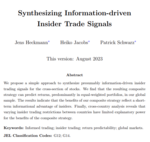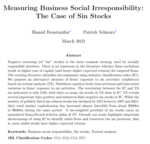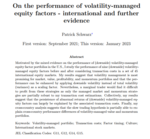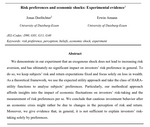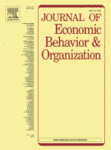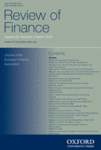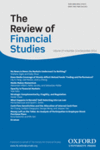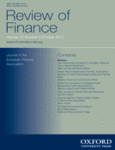Publikationen

Publikationen des Lehrstuhls
- Heckmann, Jens; Jacobs, Heiko; Schwarz, Patrick: Synthesizing Information-driven Insider Trade Signals. 2023. doi:10.2139/ssrn.4537187KurzfassungDetailsVolltextBIB Download
Abstract
We propose a simple approach to synthesize presumably information-driven insider trading signals for the cross-section of stocks. We find that the resulting composite strategy can predict returns, predominantly in equal-weighted portfolios, in our global sample. The results indicate that the benefits of our composite strategy reflect a short-term informational advantage of insiders. Finally, cross-country analysis reveals that varying insider trading restrictions between countries have limited explanatory power for the benefits of the composite strategy.
- Jacobs, Heiko: Ten selected publications (chronological). In: (2023). DetailsBIB Download
- Huber, Daniel; Jacobs, Heiko; Müller, Sebastian; Preissler, Fabian: International factor models. In: Journal of Banking and Finance, Jg.2023 (2023), Nr. 150. doi:10.1016/j.jbankfin.2023.106819KurzfassungDetailsVolltextBIB Download
Abstract
We evaluate the relative and absolute performance of competing factor-based asset pricing models in international regions and globally. Our holistic analysis controls for model transaction costs and incorporates both right-hand-side tests (based on maximum squared Sharpe ratios) and left-hand-side tests (individual return predictors, composite mispricing proxies). The overall view of the tests shows that recently proposed models tend to perform better than classical models, but otherwise perform comparably. This finding, the performance of the models in some of the LHS tests as well as further results collectively suggest the need for new powerful asset pricing models for global equity markets.
- Boustanifar, Hamid; Schwarz, Patrick: Measuring Business Social Irresponsibility: The Case of Sin Stocks. 2023. doi:10.2139/ssrn.4395028KurzfassungDetailsVolltextBIB Download
Abstract
Negative screening (of "sin" stocks) is the most common strategy used by socially responsible investors. There is no consensus in the literature whether these exclusions result in higher cost of capital (and hence higher expected returns) for targeted firms. The existing literature identifies sin companies using industry classification codes (IC). We propose an alternative measure of firms' exposure to sin activities (sinfulness) based on textual analysis (TA). Sinfulness captures both cross-sectional and time-series variation in firms' exposure to sin activities. The correlation between the IC and TA sin indicators is only 0.69, with twice as many sin stocks in TA than in IC. TA reveals several important false positive and numerous false negative sin stocks in IC. While the number of publicly listed sin-related stocks has declined by 43% between 1997 and 2021, their total market capitalization has increased almost threefold from about $200bn to $600bn during the same period. A sin-weighted portfolio of sin stocks earns an annualized Fama-French 6-factor alpha of 4%. Overall, our study highlights important shortcomings of using IC to identify sinful firms and resurrects the sin premium, that is, more sinful stocks have higher expected returns.
- Schwarz, Patrick: On the performance of volatility-managed equity factors - international and further evidence. 2021. doi:10.2139/ssrn.3951115KurzfassungDetailsVolltextBIB Download
Abstract
Motivated by the mixed evidence on the performance of (downside) volatility-managed equity factor portfolios in the U.S., I study the performance of nine (downside) volatility-managed equity factors before and after considering transaction costs in a set of 45 international equity markets. My results suggest that volatility management is most promising for market, value, profitability, and momentum portfolios and that the performance can be enhanced by applying downside volatility instead of total volatility (variance) as a scaling factor. Nevertheless, a marginal trader would find it difficult to profit from these strategies as only the managed market and momentum strategies are partially robust to my transaction cost estimations. Collectively, my results suggest that the persistence of abnormal returns of (downside) volatility-managed equity factors can largely be explained by the associated transaction costs. Finally, my cross-country analysis suggests that the slow trading hypothesis is partially able to explain cross-country performance differences of volatility-managed value and momentum portfolios.
- Dorlöchter, Jonas; Amann, Erwin: Risk preferences and economic shocks: Experimental evidence. 2021. KurzfassungPDFDetailsVolltextBIB Download
Abstract
We demonstrate in our experiment that an exogenous shock does not lead to increasing risk aversion, and has ultimately no significant impact on investors’ risk preference in general. To do so, we keep subjects’ risk and return expectations fixed and focus solely on loss in wealth. As a theoretical framework, we use the expected utility approach and take the class of HARA-utility functions to analyse subjects’ preferences. Particularly, our methodical approach affords insights into the impact of economic fluctuations on investors’ risk-taking and the measurement of risk preferences per se. We conclude that cautious investment behavior after an economic crisis might rather be due to changes in the perception of risk and return. Moreover, we give evidence that, in general, it is not sufficient to explain investors’ risk-taking solely by preferences.
- Jacobs, Heiko: Help or Hype? Journalists' Perceptions of Mispriced Stocks. In: Journal of Economic Behavior & Organization, Jg.2020 (2020), Nr. 178, S. 550-565. doi:10.1016/j.jebo.2020.07.029KurzfassungDetailsVolltextBIB Download
Abstract
The business press is a key information intermediary in stock markets, but little is known about how journalists themselves process information. To test competing hypotheses, I combine composite mispricing scores constructed from about 200 cross-sectional anomalies with the content of about two million firm-specific newspaper articles. I find that journalists tend to write positively (negatively) about stocks likely to be undervalued (overvalued). The effect is strongest for national newspapers and overvalued stocks. These and further findings collectively lend more, though not unambiguous, support to the bright side of financial journalism. In most cases, journalists act as “watchdogs”, not as “cheerleaders”.
- Jacobs, Heiko; Laudenbach, Christine; Müller, Sebastian; Schreiber, Philipp; Weber, Martin: Die genial einfache Vermögensstrategie. Verlag, Campus (Hrsg.): 1. Auflage. 2020. DetailsVolltextBIB Download
- Jacobs, Heiko; Müller, Sebastian: Anomalies Across the Globe: Once Public, No Longer Existent?. In: Journal of Financial Economics, Jg.2020 (2020), Nr. 135, S. 213-230. doi:10.1016/j.jfineco.2019.06.004KurzfassungDetailsVolltextBIB Download
Abstract
Motivated by McLean and Pontiff (2016), we study the pre- and post-publication return predictability of 241 cross-sectional anomalies in 39 stock markets. Based on more than two million anomaly country-months, we nd that the United States is the only country with a reliable post-publication decline in long/short returns. Collectively, our meta-analysis of return predictors suggests that barriers to arbitrage trading may create segmented markets and that anomalies tend to represent mispricing rather than data mining.
- Jacobs, Heiko; Hillert, Alexander; Müller, Sebastian: Journalist Disagreement. In: Journal of Financial Markets, Jg.2018 (2018), Nr. 41, S. 57-76. doi:10.1016/j.finmar.2018.09.002KurzfassungDetailsVolltextBIB Download
Abstract
By quantifying the tone of firm-specific articles in leading national newspapers between 1989 and 2010, we propose a bottom-up measure of aggregate journalist disagreement. In line with theoretical considerations, our novel high-frequency proxy for differences of opinion negatively forecasts the market return, in particular during recessions. Moreover, it has predictive power for the cross-section of stock returns. Collectively, our insights support asset pricing theories incorporating belief dispersion and highlight the role of the media in this context.
- Amann, E.; Dorlöchter, J.: Ein konvergenter Erklärungsansatz für Geldanlageentscheidungen. In: Kaluza, B; Beschorner, H.; Braun, K. D.; Rolfes, B. (Hrsg.): Betriebswirtschaftliche Fragen zu Steuern, Finanzierung, Banken und Management, Festschrift zum 66. Geburstag. Springer Gabler, Wiesbaden, 2017, S. 393-402. doi:10.1007/978-3-658-16730-1DetailsBIB Download
- Heiko Jacobs, Martin Weber: Random Walk plus Drift - Was Aktienkurse wirklich sind - Behavioral Finance Band 28. 28. Group, Behavioral Finance (Hrsg.), 2016. DetailsBIB Download
- Jacobs, Heiko; Müller, Sebastian; Weber, Martin: Anlegen mit fundierter Diversifikation - Auf der Suche nach dem bestmöglichen „Weltportfolio". 17. Group, Behavioral Finance (Hrsg.), 2016. DetailsBIB Download
- Jacobs, Heiko: Market Maturity and Mispricing. In: Journal of Financial Economics, Jg.2016 (2016), Nr. 122, S. 270-287. doi:10.1016/j.jfineco.2016.01.030KurzfassungDetailsVolltextBIB Download
Abstract
Relying on the Stambaugh, Yu, and Yuan (2015) mispricing score and on 45 countries between 1994 and 2013, I document economically meaningful and statistically significant cross-sectional stock return predictability around the globe. In contrast to the widely held belief, mispricing associated with the 11 long/short anomalies underlying the composite ranking measure appears to be at least as prevalent in developed markets as in emerging markets. Additional support for this conjecture is obtained, among others, from tests for biased expectations based on the behavior of anomaly spreads surrounding earnings announcements as well as from within-country variation in development.
- Jacobs, Heiko; Hillert, Alexander: Alphabetic Bias, Investor Recognition, and Trading Behavior. In: Review of Finance, Jg.2016 (2016), Nr. 20, S. 693-723. doi:10.1093/rof/rfv060KurzfassungDetailsVolltextBIB Download
Abstract
Extensive research has revealed that alphabetical name ordering tends to provide an advantage to those positioned in the beginning of an alphabetical listing. This paper is the first to explore the implications of this alphabetic bias in financial markets. We find that U.S. stocks that appear near the top of an alphabetical listing have about 5% to 15% higher trading activity and liquidity than stocks that appear towards the bottom. The magnitude of these results is negatively related to firm visibility and investor sophistication. International evidence and fund flows further indicate that ordering effects can affect trading activity and liquidity.
- Jacobs, Heiko: What Explains the Dynamics of 100 Anomalies?. In: Journal of Banking and Finance, Jg.2015 (2015), Nr. 57, S. 65-85. doi:10.1016/j.jbankfin.2015.03.006KurzfassungDetailsVolltextBIB Download
Abstract
Are anomalies strongest when investor sentiment or limits of arbitrage are considered to be greatest? We empirically explore these theoretically deducted predictions. We first identify, categorize, and replicate 100 long-short anomalies in the cross-section of expected equity returns. We then comprehensively study their interaction with popular proxies for time-varying market-level sentiment and arbitrage conditions. We find a powerful (relatively weak) role of the variation in proxies for sentiment (arbitrage constraints). In this context, the predictive power of sentiment is mostly restricted to the short leg of strategy returns. Our insights collectively suggest that the dynamics of sentiment combined with the base level (and not primarily the variations) of limits to arbitrage provide at least a partial explanation for inefficiencies.
- Hillert, Alexander; Jacobs, Heiko; Müller, Sebastian: Media Makes Momentum. In: Review of Financial Studies, Jg.2014 (2014), Nr. 27, S. 3467-3501. doi:10.1093/rfs/hhu061KurzfassungDetailsVolltextBIB Download
Abstract
Relying on 2.2 million articles from 45 national and local U.S. newspapers between 1989 and 2010, we find that firms particularly covered by the media exhibit ceteris paribus significantly stronger momentum. The effect depends on article tone, reverses in the long-run, is more pronounced for stocks with high uncertainty, and stronger in states with high investor individualism. Our findings suggest that media coverage can exacerbate investor biases, leading return predictability to be strongest for firms in the spotlight of public attention. These results collectively lend credibility to an overreaction-based explanation for the momentum effect.
- Jacobs, Heiko; Müller, Sebastian; Weber, Martin: How should individual investors diversify? An empirical evaluation of alternative asset allocation policies. In: Journal of Financial Markets, Jg.2014 (2014), Nr. 19, S. 62-85. doi:10.1016/j.finmar.2013.07.004KurzfassungDetailsVolltextBIB Download
Abstract
This paper evaluates numerous diversification strategies as a possible remedy against widespread costly investment mistakes of individual investors. Our results reveal that a very broad range of simple heuristic allocation schemes offers similar diversification gains as well-established or recently developed portfolio optimization approaches. This holds true for both international diversification in the stock market and diversification over different asset classes. We thus suggest easy-to-implement allocation guidelines for individual investors.
- Heiko Jacobs, Martin Weber: Aktuelle Erkenntnisse zum Momentum- Effekt - The trend is your friend - (until it’s not) . 22. Group, Behavioral Finance (Hrsg.), 2012. DetailsBIB Download
- Jacobs, Heiko; Weber, Martin: The Trading Volume Impact of Local Bias: Evidence from a Natural Experiment. In: Review of Finance, Jg.2012 (2012), Nr. 16, S. 867-901. doi:10.1093/rof/rfr022KurzfassungDetailsVolltextBIB Download
Abstract
Exploiting several regional holidays in Germany as a source of exogenous cross-sectional variation in investor attention, we provide evidence that the well-known local bias at the individual level materially affects stock turnover at the firm level. The German setting offers favorable characteristics for this natural experiment. Stocks of firms located in holiday regions are temporarily strikingly less traded, both in statistical and economic terms, than otherwise very similar stocks in non-holiday regions. This negative turnover shock is robust and survives various tests for cross-sectional differences in information release. It is particularly pronounced in stocks less visible to non-local investors, and for smaller stocks disproportionately driven by retail investors. Our findings contribute to research on local bias, determinants of trading activity and limited attention.


Abschlussarbeiten
Hier finden Sie Informationen zu unserem Abschlussarbeitenangebot.


